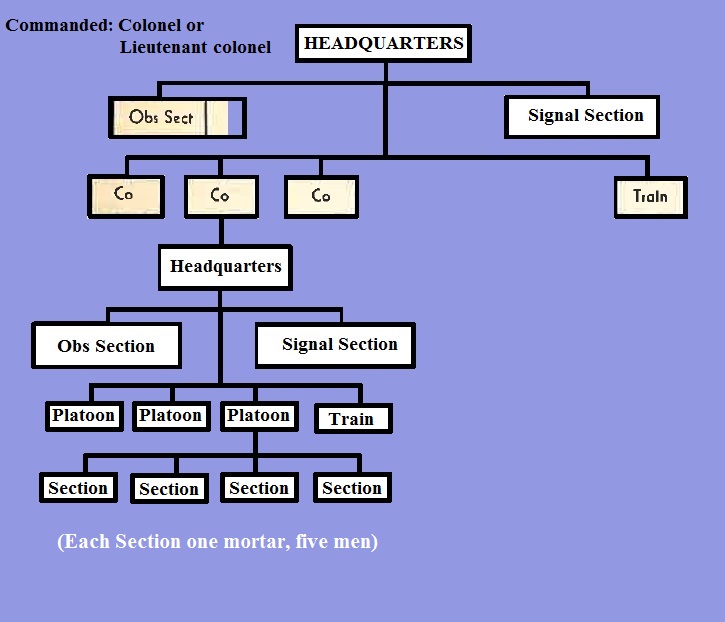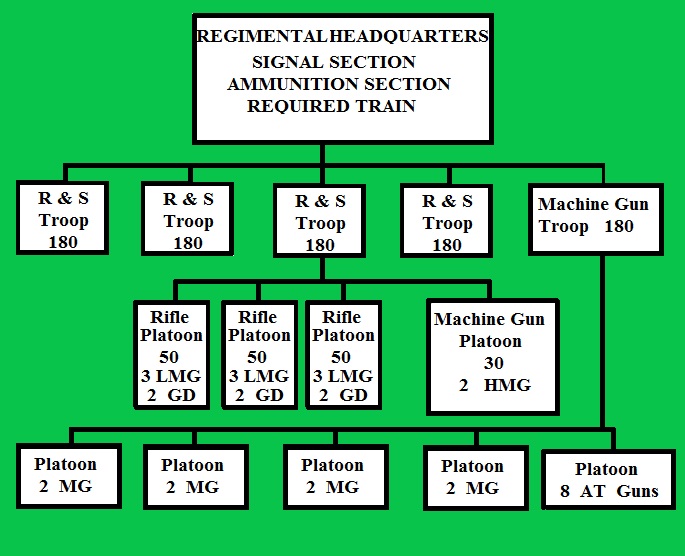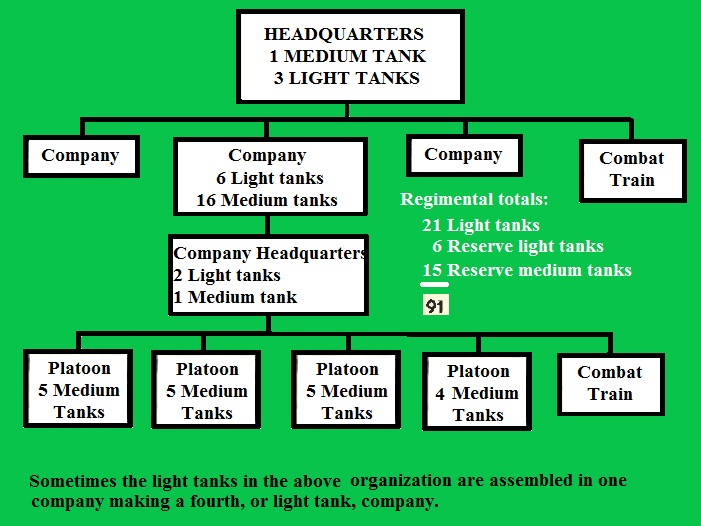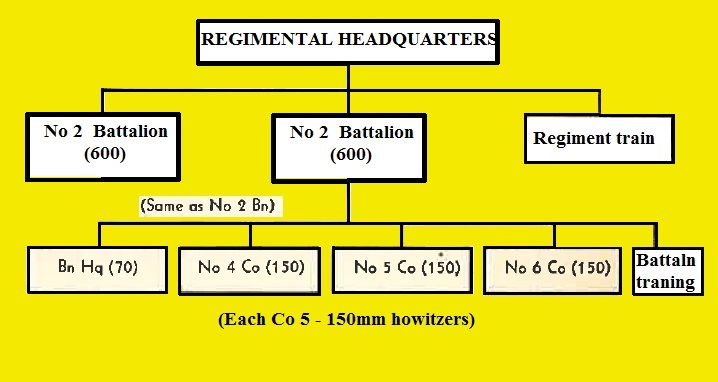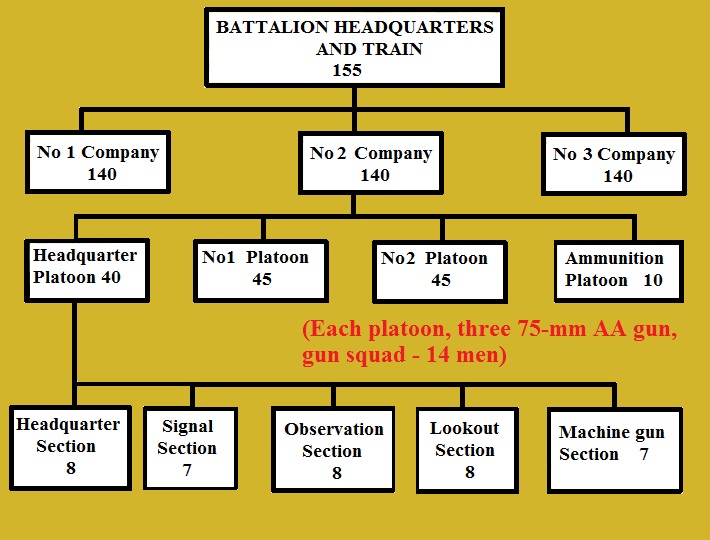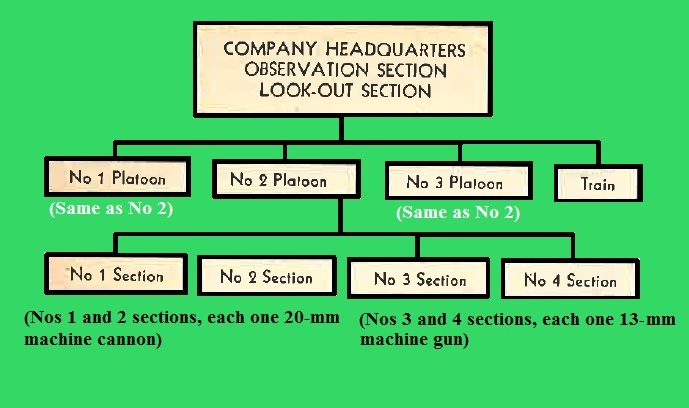(9) Other antiaircraft units.
Antiaircraft observation units and barrage balloon units are known to exist, but details of their organization are not
available. Certain units are listed as field air defense units. They appear to be in the nature of group or higher
organization headquarters, controlling all antiaircraft defense in a selected area, and have under their command
antiaircraft battalions or companies, machine cannon units, searchlight units, and possible barrage balloons or
antiaircraft obeservation units. Their size will dependentirely upon the situation and the guns and equipment
available. The larger units are commanded by major generals or colonels.
(10) Independent mortar regiment and battalions (artillery)
I addition to the Independent "infantry" mortar regiments and battalions described in paragraph 1 b, there are
other independent mortar regiments and battalions which are commended by artillerymen and probably are artillery
units. The regiments may be composed of a headquarters and 2 or more battalions. The battalions are commanded
by majors or captains and probably are divided into 3 companies.
(11) Shipping artillery.
Japanese shipping artillery regiments are designed to afford transports and other shipping protection from attack
by aircraft or submarines. The regiment normally is composed of a headquarters ans 12 companies but the 2
regiments encountered have included 6 or more additional companies. Tabular organization calls for about 2,300
men to teh regiment and about 190 men per company; operating strengths have been about 150 men per company.
Companies include antiaircraft gun companies (six 75-mm AA guns each), 75-mm field artillery companies (four
75-mm field guns each), and machine cannon companies (six 20-mm machine cannons). They are organized into
headquarters, including obsertvation and signal squads, gun platoons, and gun squads.
Units usually are broken up to operate is small detachments. Two field artillery gun sections and two machine
cannon sections frequently are assigned as the complement of small army transports.
(12) Artillery intelligence units (sound and flash).
(a) Artillery intelligence regiments.
1. General. The regiment is commanded by a lieutenant colonel and is divided into a headquarters group,
a survey unit, a plotting unit, and a sound detector unit. When horse-drawn , it is believed to
number approximately 675 officers and men.
2. Organization
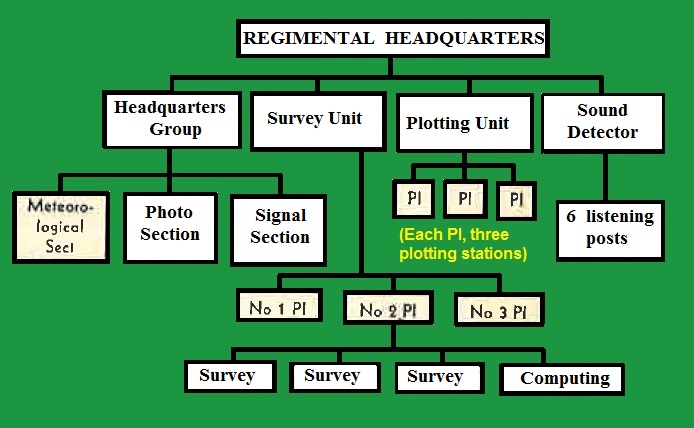
Figure 62. WWII Japanese Artillery Intelligence Regiment Organizational Chart.
|
(b) Obervation balloon regiments and companies. The Japanese are known to have balloon regiments
and companies, and such units were employed to give artillery observation during the final assault
on Singapore. A motorized balloon company is reported to have a strength of approximately 145
personnel, 23 motor vehicles, and 1 observation balloon.
|
5. ANTITANK UNITS
a. General.
Apart from the antitank gun units included in infantry organizations, there are a number of independent antitank gun battalions and
companies as well as cavalry brigade antitank units. Antiaircraft units, especially machine cannon companies, are designed to fulfill
a dual purpose role.
b. Independent antitank battalion.
(1) General.
The battalion is an 18-gun unit, with a strength of about 500 officers and men. It has been seen to operate with as few as 350. It may be
motorized, horse drawn, or pack.
(2) Oragnization (motorized) battalion.
| Commanding officer headquarters |
- 55 officers.
- 45 men.
|
| Headqurters section |
- 4 officers.
- 21 men.
|
| Transport section |
- 24 men.
|
| 3 independent antitank companies |
- 5 officers.
- 121 men, six 37-mm or 47-mm antitank guns, 15 vehicles.
|
| Headquarters section |
- 1 officer.
- 10 men.
|
| 3 gun platoons |
- 1 officer.
- 24 men, two 37-mm or 47-mm antitank guns.
|
| 2 gun squads |
- 11 men
- One 37-mm or 47-mm antitank gun.
|
| 1 ammunition platoon |
- 10 officers.
- 29 men.
|
| 1 battalion ammunition train |
-1 officer.
- 61 men.
|
(3) Its total strength is 490 men and it has eighteen 37-mm or 47-mm AT guns and 67 notor vehicles. The above personnel figure should be
increased for horse drawn or pack units.
c. Independent antitank conpany. The independent company is 6 or 8 gun unit, and, as in the case of the battalion, it may be
motorized, horse drawn, or pack. The irganization of the 8-gun unit is shown below.
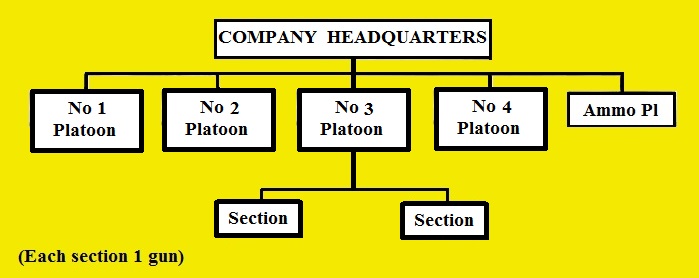
Figure 63. WWII Japanese Independent Anti tank unit Organizational Chart.
|
(1) As a pack unit, the company has 250 men, eight 37-mm guns, 2 light machine guns, 5 riding horses and 76 pack horses. As a
horse-drawn unit, the armament would be similar, but the exact strength figure is unknown.
(2) As a motorized unit, the company might number 180 to 200 and armed with eight 37-mm or 47-mm guns.
(3) Six gun units are generally similar, with strength decreased proportionately.
|
d. Cavalry brigade antitank unit.
The antitank unit of the cavalry brigade consists of three firing platoons, each of two 37-mm or 47-mm guns, and an ammuniton platoon.
The total strength is about 140 officers and men with six 37-mm or 47-mm guns.
6. ENGINEERS
a. Enginner groups.
These are administrative units commanded by a genral officer. They supervise engineer activity and control independent engineer
units in a theater of operations.
b. Independent engineer regiments.
These units are often attached to divisions in the field. They are divided into the following six different types according to the
proncipal function they fulfill:
| TYPE |
FUNCTION |
| 'A' KO |
----- Open warfare. |
| 'B' OTSU |
----- Position warfare. |
| 'C' HEI |
----- Heavy bridge building. |
| 'D' BO |
----- Shipping-landing operations. |
| 'E' TEI |
----- River crossing. |
| 'F' KI |
----- Attacking pillboxes and special firing positions. |
|
They are similar in general organization, consisting of a regimental headquarters, 3 companies, and a material platoon. The tabular
strength of each is approximately 1,000 men. The commanding officer is a colonel or lieutenant colonel.
Companies are composed of 4 plattons of 4 or more squads each an average of 250 to 300 men. The number of motor trucks varies.
|
Personnel carry rifles and probably some light machine guns. It has been noted that regiments are prepared ti undertake special
duties other than those for which they are designated.
c. Independent engineer battalions,
These are known to exist. They are commanded by lieutenant colonels or majors.
d. Independent engineer companies.
These units consist of a headquarters and 2 platoons of 3 or 4 sections each. One unit had an operational strength of approximately 165
officers and men.
e. Field road construction units.
These are engineer troops organized into a unit of a headquarters and 2 or 3 companies. Duties are general construction, particularly of
roads and airfields. Units are commanded by lieutenant colonels and majors; companies are estimated to have about 125 officers and
enlisted men.
f. Bridge-building and river crossing material companies.
These units consist of personnel and equipment for bridge building and river crossings. Strengths vary from 250 to 600, depending
upon whether they are draft or motorized.
g.
(See shipping units, anchotages, see section II, par 2 c., page 50)
7. CHEMICAL WARFARE
a. The Japanese are known to have a chemical warfare service and organized chemical warfare units. The division units previously
have been discussed (See page 1/m). Besides these, gas battalions and independent gas companies are known to exist. The Japanese have
used sternutatory or suffocating gas in China. They have established factories for poison gas manufacture, developed anti-gas measures,
and issue an efficient gas mask to their services. They, therefore, should be considered capable of gas warfare.
b. Picked personnel from all Japanese units are trained in decontamination and antigas work. Although normally acting as regular
troops, such personnel are especially equipped to carry out chemical warfare duties; upon occassion they may be formed in temporary
smoke (gas) units for the conduct of offensive chemical warfare. It is estimated that there are about 250 such men in an infantry
regiment or its equivalent.
8. AIRBORNE UNITS
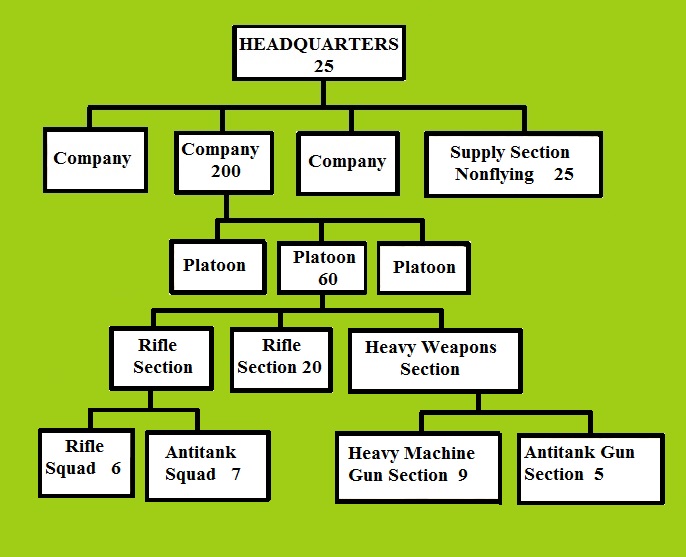
Figure 64. WWII Japanese Airborne Units Organizational Chart.
|
a. General.
The Japanese army raid-training department has experimented with airborne units, and it is probable that in addition to known parachute
units some airborne troops are available for service. The Japanese have referred to an airborne force composed of a glider force and
parachute force but give no details.
b. Parachute force.
The parachute force has been described as composed of a headquarters, two parachute battalions, and an artillery unit. Total strength is estimated
to be about 1,750.
c. Parachute battalion.
The battakion us composed of a headquarters and 3 companies with a small nonflying supply section. Companies are 3 platoons, each of 2
rifle sections and 1 heavy weapons section. A rifle section has 6 riflemen and an antitank group. The heavy weapons section has a
heavy machine gun section of 9 men, and a cannon section of 5 men. The total strength is estimated to be about 600 to 700.
|
SECTION III - SERVICES (Non-divisional)
1. GENERAL.
The services of the Japanese army are:
- Intendance.
- Technical, including ordnance.
- Medical.
- Veterinary.
- Judicial (legal).
- Military band.
2. TRANSPORT. Transport is divided into road (animal and mountain),
railway and water units.
a. Road transport units.
(1) General. Transport regimentd of depot divisions form the source of personnel for division and
independent transport regiments as well as for other units requiring transport personnel.
(2) Field transport commands. ( Yasen Yusobu ). These are usually
commanded by major generals. They are administrative organizations probably controlling all
independent transport units under an army command.
(3) Field motor transport depots ( Yasen Jidoshasho ). These are usually
under command of a colonel or lieutenant colonel, except in the larger theaters of operations (Asiatic
mainland) where a major general commands. They are believed to be administrative units responsible for
storage, maintenance, and control of motor transport in a given operational area.
(4) Independent transport regiments (horse). These are estimated to number about 3,000 officers
and men. Commanded by a colonel or lieutenant colonel, they are composed of a headquarters, and
from 4 to 8 draft or pack transport companies.
(5) Motor transport regiments. These consists of about 1,500 officers and men with 300 vehicles.
They are commanded by a colonel or lieutenant colonel.
(6) Independent transport battalions (horse). These are estimated at about 1,700 officers and
enlisted men and usually are commanded by majors. They are composed of a headquarters and 3 to 4
draft or pack transport composed.
(7) Independent motor transport battalions. These are estimated at about 800 officers and enlisted
men divided into a headquarters and three companies. Usually commanded by majors, they are believed
to be equipped with about 150 one and one half ton trucks.
(8) Independent transport companies (horse). These are estimated at about 350 officers and enlisted
men, and commanded by captains or first lieutenants. They usually are equipped with about 200 to
250 single horse, 2-wheel, transportation carts (1/4 ton).
(9) Independent motor transport companies. Estimated at about 175 officers and men and about 50 trucks,
these units are commanded by a captain or first lieutenant. They are divided into 3 platoons and
maintenance section, with the platoon consisting of 4 or 5 sections each.
(10) Provisional transport unites. such units, formed by assigning combat or service elements other than
transport to provisionally formed transport units, will be found operating behind the lines. Their size,
organization, and equipment will vary depending upon their mission; after its completion they return to
normal duties.
(11) Line of communication transport supervision detachments. These consist of military and civilian
personnel, whose duties are to supervise and control locally commandeered transport.
b. Railway units.
(1)
Railway commands (Tetsudo Bu),
Field railway ( Yasen Tetsudo),
Special railway (Tokusetsu Tetsudo), and
Railway transport (Tetsudo Yuso).
These units are believed to maintain, control, and coordinate rail traffic in the larger theaters. They
are composed of a headquarters, one or more railway regiments, supply depots, and construction and
operation units. They are commanded by genral officers.
(2) Railway Regiment. The railway regiment consists of headquarters, 4 battalions (2 companies of 4 platoons),
and a supply depot. Strength is approximately 2,500 officers and enlisted men, commanded by a colonel or
lieutenant colonel. such regiments are designed to operate and guard railways.
(3) Armored train units. These are reported to consists of about 500 officers and enlisted men (infantry,
artillery, and engineers) and to operate armored trains.
c. Water (shipping) units. Water (shipping) units are headed by a sea transport headquarters
in Japan.
(1) Branch officer. Termed shipping groups, are situated at the principal base ports in theaters
of operations. They control a veriable number of shipping engineer requirements and embarkation units.
(2) Shipping Engineer Regiments. These units are the large operations in the Japanese Army. They
are equipped with the necessary landing craft and equipment for amphibious operations and movement of
supplies and men. Organizational strength approximates 1,200 officers and enlisted men, divided into
a headquarters and 3 companies of several sections each. A lieutenant colonel normally commands. The
regiment is equipped with 150 to 200 alnding craft of all types.
(3) Debarkation Units. These include necessary personnel and equipment for the loading and
unloading of transports at the more forward bases or during landing operations. Strength is estimated
at 1,000 officers and enlisted men.
(4) Shipping transport commands (headquarters). These, like shipping groups, are situated at the
principal base ports, where they are responsible for the shipping installations at these bases. They
also fuel vessels, store cargoes and, in conjuction with the Navy, plan and route sea transport in a
given area. Size of the unit depends on the volume of shipping in the theater.
(5) Shipping transport area units. These are variable sized units responsible for the armament and
defense of vessels operating in a particular area. They control shipping ordnance, shipping antiaircraft
artillery, and shipping signal units, dettachments of which are assigned for the defense of
intercommunication between vessels and convoys.
(6) Anchorage units. These are believed composed of a headquarters and variable number of land
duty, water duty, and construction duty companies. Respectively, these companies are probably a
stevedore company of approximately 350 officers and enlisted men, a barge and ligheter operations
company of the same strength, and a general construction engineer company probably also of the same
strength.
(7) Shiopping transport battalions. The existance of these units is known, but details of their
orgnization are lacking (as of 1944). They are believed to operate small sailing and motor craft.
3. INTENDANCE.
a. General. Intendance service is responsible for clothing, rations, forage, contratcs, pay,
and the upkeep of army buildings. It is a separate organization combining functions of the
U.S. Army Quartermaster Corps and Finance Department. it is under the control of the intendance
Bureau of teh War Ministry. Intendance personnel are assigned to armies, divisions, and lower
units, they also are found at various depots, factories, and other places requiring accounting
and quartermaster services.
b. Field Freight Depots. They are to be found functioning as units or split into branches
along the lines of communication of armies. Each depot is responsible for the supply of
several divisions. They store and supply rations, clothing, and other supplies.
4. ORDNANCE (TECHNICAL SERICE).
a. General. Prior to organization of the technical service ( Gijutsu Bu )
in 1941, ordeance duties in the Japanese army were performed by personnel detailed from various branches,
usually artillery and engineers, who functioned under general supervision of the ordnance bureau of the
War Ministry. At present, however, ordnance personnel belong to the technical service. As the name
implies, this service includes the various types of technicians in the army, such as gunsmiths, mechanics,
electricians, saddlers, etc. All of whom may be attached to units as required.
b. Functions. Ordnance personnel are responsible for provide arms, ammunition, engineer stores, and
supplies not furnished by the intendance service. Ordnance functions are discharged in the field by
field ordnance depots, stattioned at principal rear bases. Size of these depots will vary according
to the theater of operations, and branches will be fond along the lines of communications.
5. MEDICAL.
a. General.
The medical service is a separate service functioning under the medical bureau of the War Ministry. In addition
to divisional medical service, the following are known to exist:
b. Casualty clearing stations.
These are unassigned medical units with strength of approximately 100 officers and enlisted men. They evacuate
casualties from the division field hospitals to line of communication hospitals.
c. Line of communication hospitals.
These , with a strength of about 250 officers and enlisted men, can accomodate 500 to 1,000 patients. They
consists of 2 sections and are usually found at rear bases or along the lines of communication.
d. Army hospitals.
These are larger hospitals of varying size generally situated well behind forward base areas.
e. Base hospitals.
In each home divisional district, there are hospitals to meet the requirements of the various units in
peacetime. These, as well as private and other government hospitals, are utilized as base hospitals during
wartime.
6. VETERINARY.
This is a separate service which functions under the horse administration section, military administration bureau, of teh War Ministry.
A veterinary department or section is attached to the staff of armies, area armies, divisions, and other oversea commands, while
dettachments operate with all units containing animals.
Vetererinary hospitals, with a staff of about 150 capable of handling 700 sick horses, and veterinary quarantine hospitals are found along
the lines of communication or at bases.
7. SIGNAL.
a. Before the war the functions of the signal corps were performed by communication units of the corps
of engineers. In 1941, however, an Inspectorate of Communications was set up directly subordinate to
the War Department General Staff. This was tantamount to the establishment of a separat esignal corps.
Troops are classified as signal communications men.
b. The signal regiment (army signal unit).
(1) The regiment is composed of a headquarters, several wire companies (motor, draft or pack), several radio
platoons (motor, draft or pack), a fixed radio unit, a radio interpret unit, and a field pigeon unit.
(2) The headquarters consists of about 120 officers and enlisted men, and includes a transport section, a
repair section, and an air-ground radio section.
(3) The wire companies' approximate strength are 250 men draft, 320 pack, and 300 motor. They are believd to
be equipped with 36 telephones and 8 telegraph instruments. The draft and pack companies carry about 35
miles of wire, while the motor companies carry 70 miles. Companies include a signal platoon, 3 maintenance
platoons and a transport platoon.
(4) Radio platoons operate 1 radio station. They include draft, pack or motor transportation and are of 35 to
45 men in strength.
(5) The fixed radio unit has a strength of about 25 officers and enlisted men and operates a long
distance radio station.
(6) The radio intercept unit is divided into a headquarters with train, an intercept unit equipped with
6 receivers, and a direction finding unit equipped with 4 direction finders. Its strength is
approximately 290 officers and enlisted men.
(7) The pigeon unit has a headquarters of some 20 officers and men, including a train, as well as several
pigeon platoons. a platoon has about 50 men and is divided into 3 sections, each equipped with 40
carrier pigeons.
(8) Although complete signal regiments as outlined above are likely to be found operations with the larger
headquarters, it will be more usual to find their individual components operating as independent units
on the line of communication or with smaller organizations in the field to supplement their signal
networks.
8. ARMY POSTAL SERVICE.
The Japanese Army's postal system operates through networks of central, field, and branch post offices
set up in forward and rear areas. APO numbers evidently are assigned to localities, rather than to units,
and remain fixed. In certain instances field post offices may act as paying agencies for the army, in
addition to accepting and delivering military mail and handling postal money orders and military postal
savings. A free Air-mail service for military personnel is reported in operation.
9. JUDICIAL.
The judicial (legal) service of the Jaoanese army formerly was entirely in the hands of civilians attached
to various units. In 1941 these civilians were commissioned in the Army, where they continue to perform
their usual legal duties.
10. MILITARY BAND.
This service furnishes the personnel for the Japanese army bands. These bands do not appear to have any
secondary duties.
SECTION IV - MILITARY INTELLIGENCE
1. GENERAL.
Military intelligence is a function of the 2nd Bureau, Army General Staff, headed by a major general. Intelligence of a more general nature
flows to the high command through a complex organization, at the top of which is the Intelligence Department fo the Imperial General
Headquarters. In a subordinate position, there is also he Central Commission for intelligence, a coordinating body which maintains contact
with all goivernment dettachments and disseminates information. Intelligence received from armed forces in the field is routed through the
usual military channels to the 2nd Bureau of teh General Staff. This purely military function resembles the system employed by other
armies.
2. COMBAT INTELLIGENCE.
Intelligence officers are assigned to army, division, and regimental staffs. While they appear to have no permanently organized units for
collecting combat intelligence, geographic areas are assogned to various regular units which are made responsible for the susual items of
information sought in combat intelligence. It is noteworthy that the Japanese recently have been stressing the amount of military
information that can be gathered from prisoners of war and from captured documents.
3. THE TOKOMU KIKAN (SPECIAL SERVICE AGENCY).
This agencuy is believed to be directly under orders of the Imperial General Headquarters and organized into units which are assigend only
to armies or geographical areas, espionage, counterespionage, propaganda, and fifth column activities, together with a measure of undercover
supervision over occuppied territories, appear to be principal duties of personnel and agency.
A major general was declared to be in command of the Tokumu Kikan organization at Canton in 1942. Close cooperation between the Tokumu
Kikan and military police apparently can be effected when required, in as much as counterespionage is included among the duties of the
latter. (For details of the Japanese military police service, See Chapter 6).
SECTION V - REORGANIZATION
1. GENERAL.
Manuy indications show that the Japanese Army is in the process of reorganizing (1944) and modernizing various
units. Some of this modernization program has been accomplished and it must be expected that there will be
continued progress. On the other hand there are definete limitations to the speed with which equipment can
be obtained and distributed, and personnel indoctrinated and trained. It is believed, therefore, that while
there will be a gradual increase in the number of the stronger and more modern units the bulk of the army will
continue to be compressed, as it is at present, largely of average organizations such as have been described.

